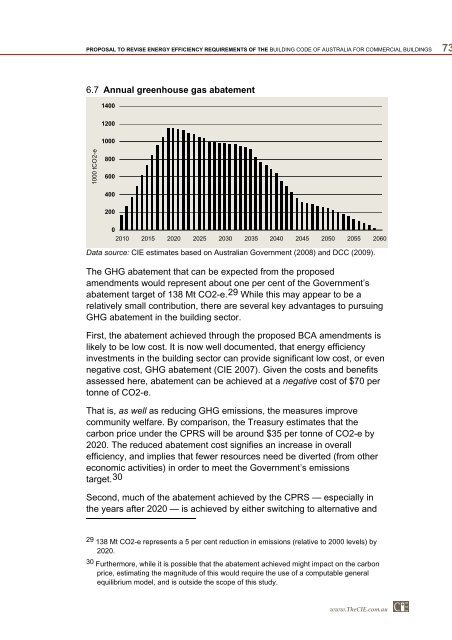PDF | 2 MB - Australian Building Codes Board
PDF | 2 MB - Australian Building Codes Board
PDF | 2 MB - Australian Building Codes Board
Create successful ePaper yourself
Turn your PDF publications into a flip-book with our unique Google optimized e-Paper software.
PROPOSAL TO REVISE ENERGY EFFICIENCY REQUIREMENTS OF THE BUILDING CODE OF AUSTRALIA FOR COMMERCIAL BUILDINGS 73<br />
6.7 Annual greenhouse gas abatement<br />
1400<br />
1200<br />
1000<br />
1000 tCO2-e<br />
800<br />
600<br />
400<br />
200<br />
0<br />
2010 2015 2020 2025 2030 2035 2040 2045 2050 2055 2060<br />
Data source: CIE estimates based on <strong>Australian</strong> Government (2008) and DCC (2009).<br />
The GHG abatement that can be expected from the proposed<br />
amendments would represent about one per cent of the Government’s<br />
abatement target of 138 Mt CO2-e. 29 While this may appear to be a<br />
relatively small contribution, there are several key advantages to pursuing<br />
GHG abatement in the building sector.<br />
First, the abatement achieved through the proposed BCA amendments is<br />
likely to be low cost. It is now well documented, that energy efficiency<br />
investments in the building sector can provide significant low cost, or even<br />
negative cost, GHG abatement (CIE 2007). Given the costs and benefits<br />
assessed here, abatement can be achieved at a negative cost of $70 per<br />
tonne of CO2-e.<br />
That is, as well as reducing GHG emissions, the measures improve<br />
community welfare. By comparison, the Treasury estimates that the<br />
carbon price under the CPRS will be around $35 per tonne of CO2-e by<br />
2020. The reduced abatement cost signifies an increase in overall<br />
efficiency, and implies that fewer resources need be diverted (from other<br />
economic activities) in order to meet the Government’s emissions<br />
target. 30<br />
Second, much of the abatement achieved by the CPRS — especially in<br />
the years after 2020 — is achieved by either switching to alternative and<br />
29 138 Mt CO2-e represents a 5 per cent reduction in emissions (relative to 2000 levels) by<br />
2020.<br />
30 Furthermore, while it is possible that the abatement achieved might impact on the carbon<br />
price, estimating the magnitude of this would require the use of a computable general<br />
equilibrium model, and is outside the scope of this study.<br />
www.TheCIE.com.au
















